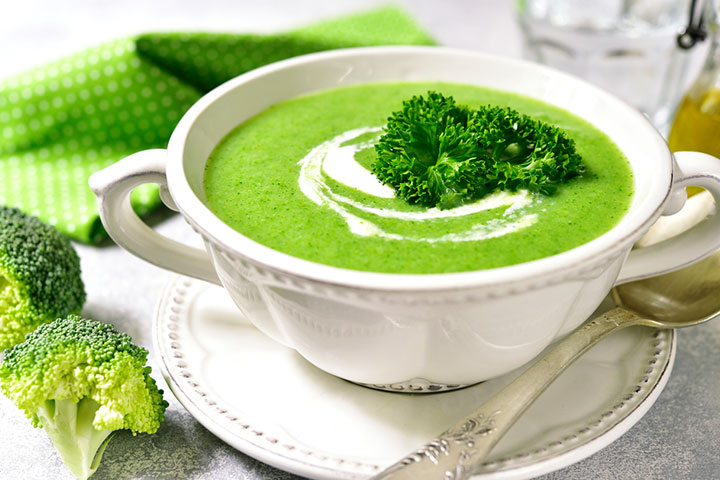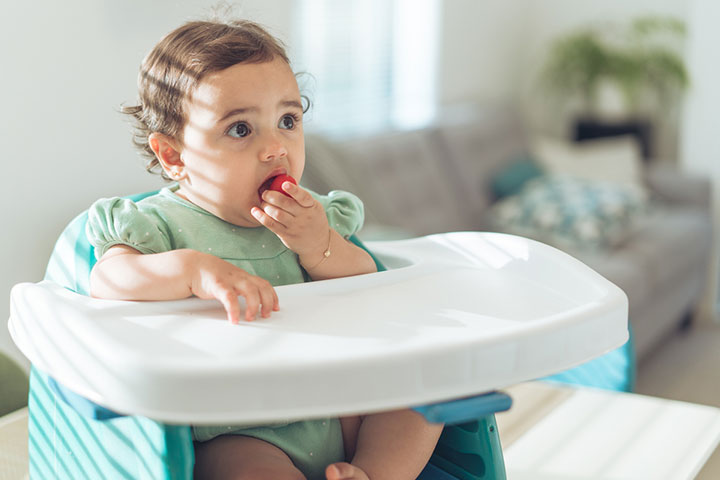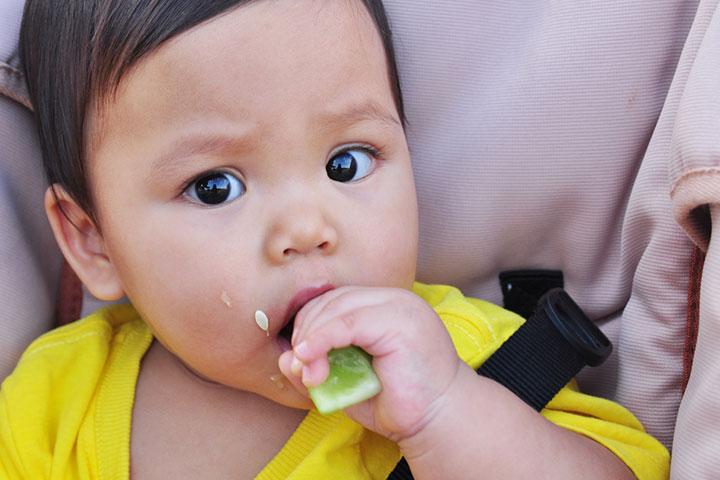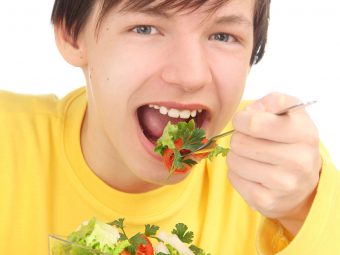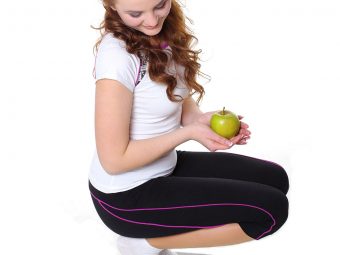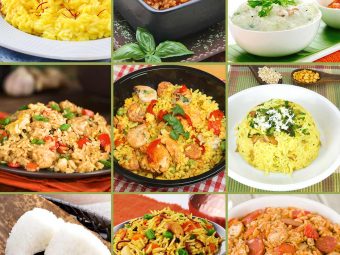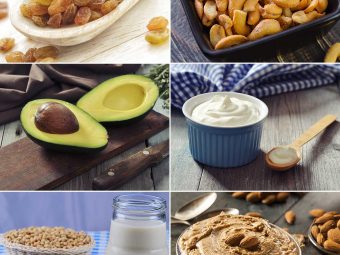
Image: Shutterstock
The benefits of vegetables for babies are numerous. They are vital sources of essential nutrients and must be included in your baby’s diet. Additionally, vegetables add flavor to dishes and are rich in dietary fiber, vitamins, and minerals. These nutrients are required for your baby’s optimum growth and development.
Your pediatrician may have asked you to include vegetables in your baby’s diet, but you may be unsure about which vegetables to choose and how to include them in the diet. Read on to discover the types of vegetables you may give your baby and some age-appropriate ways to include them in your baby’s diet.
Vegetables Suitable For Young Babies (6 months onward)
Most babies begin solids from six months of age(1).Babies in this age bracket are young, and their oral skills anddigestive systemare still under development. It is why the veggies you feed them should be easy to swallow and digest.
Here are a few vegetables suitable for young babies(2).
1.Carrots:Well-cooked carrots blend easily, and you can serve them as soon as the baby begins solids. Carrots add color to a baby’s weaning diet and offer essential nutrients. Beta-carotene (vitamin A) in carrots supports healthy eye and skin development(3). The dietary fiber adds bulk to the dietand acts as alaxativeiXA substance that promotes stool mobility and is used to treat constipation.(4).
 Did you know?
Did you know?2.Peas:Green peas are an excellent source of protein and vitamin B1 for young babies. While protein aids in the baby’s growth, vitamin B1 supports healthy brain development and function(5). You can steam or boil frozen peas and then puree them to a smooth-flowing liquid that young babies enjoy eating. They are also a greatfinger foodfor older babies and toddlers.
3.Spinach:Spinach is a nutrient-rich leafy vegetable that can offer vitamin A, B2, B6, B9 (folate), K, potassium, and iron(6). Steam or boil and blend the spinach to make a smooth puree. You can add breast milk or formula to adjust the puree’s consistency if needed.
Image: IStock
4.Sweet potatoes:This sweet-tasting veggie is an easy-to-digest food for young babies. You need to boil and blend it to make the puree. You can also feed it as a mash once your baby adjusts to its taste and digestibility.Beta-caroteneiXA pigment that gives an orangish hue to certain vegetables.,vitamin C,potassiumiXAn essential mineral and electrolyte that the body tissues need., and dietary fiber are some notable nutrients found in sweet potatoes(7).
5.Pumpkin:Pumpkin is a winter squash variety. It is one of the most common food choices for weaning babies due to its smooth texture and easy digestibility. Feeding a pumpkin can offer your baby phytochemicals, such as beta-carotene,luteiniXA naturally occurring xanthophyll and carotenoid found in the human eye., andzeaxanthiniXA naturally occurring xanthophyll and carotenoid., promoting long-term health. Besides, it can provide essential nutrients, such as vitamin C, B6, potassium,magnesiumiXAn essential mineral required for the proper functioning of muscles, bones, nerves, etc., and fiber(8).
6.Broccoli:Broccoli is a nutrient-dense vegetable that contains vitamin A (beta-carotene), vitamins B6, B9, C, and K (9).Babies can eat broccoli in smooth puree and mashed form. Older babies can eat steamed or boiled, bite-sized broccoli pieces as healthy finger food.
Image: IStock
As your baby grows, their oral skills and digestive system develop. They can try many more vegetables in puree, mash, and soft finger foods.
Vegetables Suitable For Older Babies (8 months onward)
Here’s a list of some nutrient-rich vegetables that your baby can eat from around eight months of age.
7.Zucchini:Zucchini is a nutritious food that can provide your baby vital micronutrients such as vitamin C, folate, magnesium, and potassium(10). You can introduce zucchini mash or puree to your baby, and as they adjust to its flavor, introduce zucchini soup. Zucchini noodles are a good finger food choice to encourage self-feeding.
8.Eggplant:Brinjal, eggplant, or aubergine, when cooked, serves as a delectable veggie for babies. You can feed boiled, steamed, roasted, grilled, or baked eggplant slices to older babies as finger food. However, several parents prefer feeding eggplant puree and mash before offering it as cooked slices. When consumed regularly, aubergine can provide fiber, potassium, zinc, manganese, and folate(11). These nutrients are vital for the body’s growth and physiological processes.
 Quick tip
Quick tip9.Tomato:Tomato contains severalbioactive compounds i XExtranutritional chemicals found in plant foods., such aslycopene i XA carotenoid that gives a bright red color to certain vegetables., beta-carotene, and vitamin C. You can feed tomato to your baby as tomato soup. Alternatively, you can cut them into bite-sized, thin pieces and serve them raw as finger food to older babies. If you are offering cherry tomatoes to your baby, cut them lengthwise into thin slices.
Image: IStock
10.Onion:Along with adding flavor and texture, onions also add nutrients to the foods. Older babies can relish their flavor by nibbling oncooked onion rings. Besides, you can add onion to different foods, such as soups, curries, casseroles, and different lentil preparations.
11.Beetroot:Beets are rich in potassium, magnesium, dietary fiber,phosphorusiXAn essential mineral that is a key ingredient in many body parts, including teeth and bones., iron, beta-carotene, vitamin A, C, and B9 (folate)(12). Babies may not like its taste, but you can resolve this issue by mixing beetroot puree or mash with delicious fruits, such as blueberries and mango.
Cauliflower, French beans, and mushrooms are other healthy and nutritious vegetables that older babies can relish.
Vegetables Suitable For Baby-Led Weaning
As a baby shows developmental readiness to consume solids, some parents may consider baby-led weaning. Here are some vegetables that are most suitable for self-feeding.
12.Butternut squash:Soft texture, easy digestibility, and sweet taste are some of the notable qualities of butternut squash that make it an excellent choice for baby-led weaning. Nutritionally, butternut squash provides almost the same nutrients as pumpkin(11). You can serve its puree or mash with several foods, such as mashed tofu, quinoa, rice, and oats.
Image: Shutterstock
13.Potato: Potato is an energy-dense vegetable containing essential nutrients, such as vitamin B6, C, and potassium(12). You can serve thinly sliced, bite-sized, steamed, grilled, or roasted potato slices/wedges with avocado dip to babies for baby-led weaning.
14.Bell peppers:Bell peppers are rich in fiber, vitamin C, B9 (folate), and potassium(13). Cooked, thinly sliced strips and bite-sized cubes of bell pepper make a good baby-led weaning food. Serve bell peppers with unsweetened yogurt or homemadehummusiXA Mediterranean dip made from chickpeas.to intensify their nutritional benefits. Use orange or yellow bell peppers for babies as they are sweeter.
15.French beans:French beans or green beans are fiber-rich vegetables that offer vitamin A, potassium, magnesium, calcium, and iron. These vital nutrients support thebaby’s eye development, immune system functions, and physical growth. Steamed and boiled green beans, cut into two-inch long pieces, are a good choice for baby-led weaning.
16.Cucumber:Cucumber is a hydrating vegetable that offers nutrients, such as fiber, sodium, potassium, folate, and vitamin K(14). Peeled cucumbers sliced into bite-sized cubes is a good choice for baby-led weaning.
Image: Shutterstock
Vegetables To Avoid For Babies
Here’s a list of vegetables that you should avoid feeding babies, especially young babies(17)(18).
- Raw vegetables, such as baby carrots, corn, and celery, are a potentialchoking hazardfor babies. However, babies can eat these veggies in puree and mash forms after thorough cooking. For older babies who can chew, you can serve cooked baby carrot and celery slices cut into thin, bite-sized slices as finger food.
- Root vegetables, such as beetroots and turnips, and some leafy vegetables, such as kale and spinach, are high in nitrate. These should not be fed to babies younger than six months. Nitrate is a compound that vegetables absorb from the soil, and its excess intake may cause a condition called methemoglobinemia or blue baby syndrome. It is a blood disorder characterized by abnormal production of methemoglobin — a type of hemoglobin that carries oxygen but can’t release it to body tissues effectively. Some of the symptoms that the condition may exhibit are bluish coloration of the baby’s hands, feet, and mouth, failure to thrive, fatigue, and shortness of breath.
Frequently Asked Questions
1. Can I give my baby mixed vegetables?
Yes, you can give your baby mixed vegetables, but it’s recommended to introduce one new food at a time every 3-5 days to watch for any potential allergens(19). This will allow you to identify and avoid any problematic vegetables for your baby.(19). Once the baby adjusts to the taste and digestibility of different veggies, you can add the mixed veggies to other foods, such as wheat, barley, millet, and couscous to prepare wholesome and healthy baby foods.
2. Are frozen veggies good for babies?
Frozen veggies are a good option for making baby food(20). They retain their nutritional value and help incorporate healthy foods into your baby’s diet. Just be sure to select options with no added sugar or salt when shopping(21). However, it is best to buy pesticide-free, organic vegetables from nearby farm markets or stores to ensure the safety and quality of baby food.
3. Should babies eat vegetables or fruit first?
You have the freedom to choose between vegetables or fruit when introducing solid foods to your baby. There is no right or wrong order and both options are equally good to begin with(19).
4. How do I cook frozen veggies for babies?
You can cook frozen veggies the same way as fresh ones by steaming or microwaving them when preparing baby food. Frozen vegetables do not usually need to be thawed before cooking.
5. How do I add flavor to frozen vegetables?
You may add olive oil or butter to purees for babies. Depending on the recipe, spices such as powdered nutmeg or cinnamon may be added to enhance the taste(23).
6. How do I steam baby food without a steamer?
If you do not have a steamer, you may use a thick-bottomed pan with a tight lid. Place a steel stand (or you may use balls made of aluminum foil) to support a heat-proof plate over it. Pour water to about half an inch height inside the pan and place your veggies on the plate. Now bring the water to boil and cover it with the lid. You may also use a colander in place of the stand and plate.
蔬菜富含许多营养,纤维、维生素amins, and minerals. Vegetables provide vital nutrients for a baby’s growth and development. Eating vegetables of different colors is a habit that people make and may help them through their lives. Colorful veggies can help you lure your child into experimenting and trying new foods. You can introduce vegetables to babies as soon as six months of age or whenever you introduce solids. Initially, you may offer them vegetables in pureed form and then proceed to other age-appropriate forms.
Infographic: Guide On Feeding Vegetables To Babies
Vegetables form the core nutritious ingredients of any diet plan and are essential for babies’ healthy growth and development. But getting children to eat veggies is a struggle for most parents, as it entails time and patience. So try the feeding tips from this infographic and learn about the right portion sizes to include for your baby.
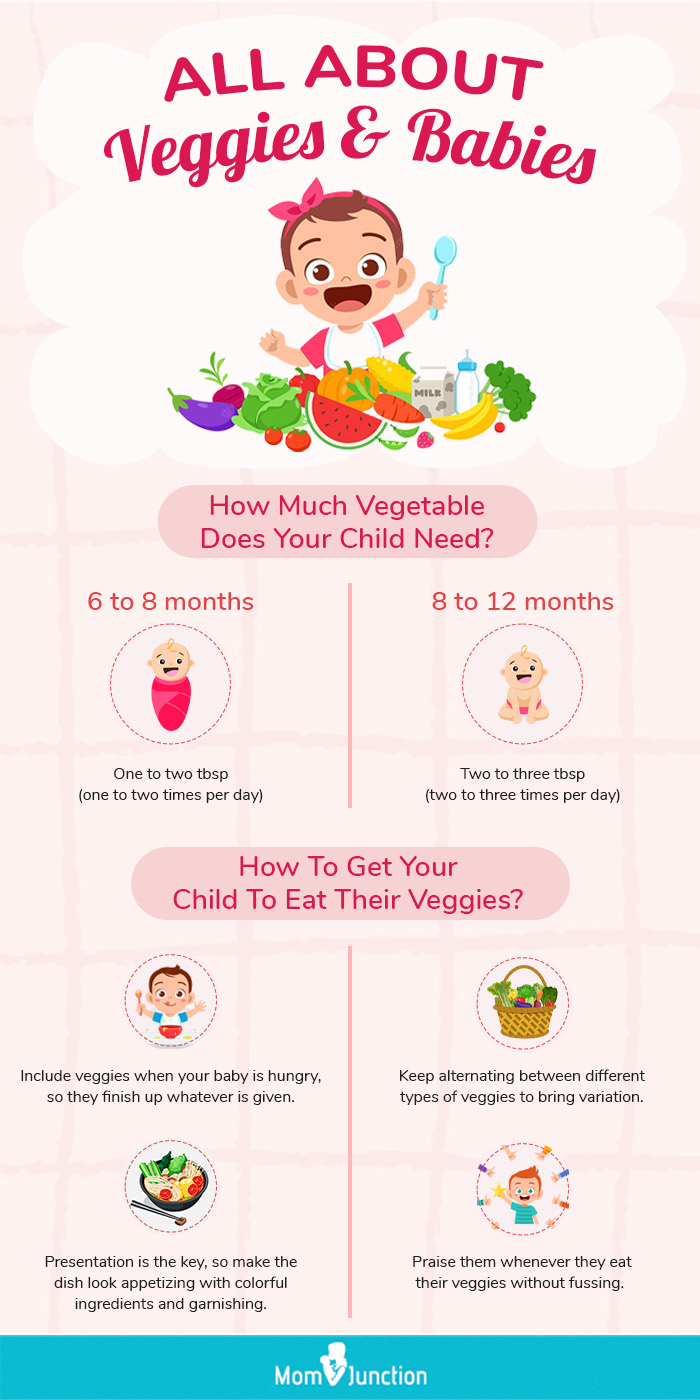
Illustration: Momjunction Design Team
Get high-quality PDF version by clicking below.
Download Infographic
Key Pointers
- Babies can start eating solid foods after six months of age.
- Start with soft-boiled vegetables such as carrots, sweet potatoes, or pumpkin.
- Potatoes, beans, and bell peppers are good choices for weaning.
- Avoid raw vegetables as babies may find it difficult to chew and digest.
References:
2.9 Best Vegetables Your Baby Should Eat;New Kids Center
3.Vitamins: Their Functions and Sources;Michigan Medicine
4. Pieter Van den Abbeele et al.;A Novel Non-Digestible, Carrot-Derived Polysaccharide (cRG-I) Selectively Modulates the Human Gut Microbiota while Promoting Gut Barrier Integrity: An Integrated In Vitro Approach;NCBI
5.Vitamin B1 (Thiamine);Mount Sinai
6.Spinach;Produce for Better Health Foundation
7.Sweet Potatoes;Harvard T.H. Chan
8.Winter Squash;Harvard T.H. Chan
9.Broccoli;Health And Social Services
10.Squash, summer, zucchini, includes skin, cooked, boiled, drained, without salt; FDC ID: 169292;FoodData Central
11.Eggplant, cooked, boiled, drained, without salt; FDC ID: 169229;FoodData Central
12.Drop the Beet on Your Diet;Northwestern Medicine® and Northwestern Memorial HealthCare.
13.Winter Squash, Pumpkin, and Sweet Potato;American Institute for Cancer Research
14.Potatoes, nutrition and diet;FAO
15.Peppers;University of the District of Columbia
16.Cucumber, peeled, raw; FDC ID: 169225;FoodData Central
17.Food For Baby’s First Year;Florida Department Of Health
18.Nitrates, Blue Baby Syndrome, And Drinking Water: A Factsheet for Families;PEHSU
19.Starting solid foods; American Academy of Pediatrics
20.How to Make Homemade Baby Food; Academy of Nutrition and Dietetics
21.Frozen Foods: Convenient and Nutritious;Academy of Nutrition and Dietetics
22.Reasons Why Carrots (of All Colors) Are Healthy For You; Cleveland Clinic
23.Becky’s Bulletin; Becky Gates Children’s Cente




